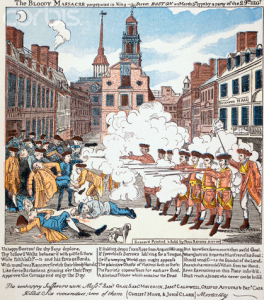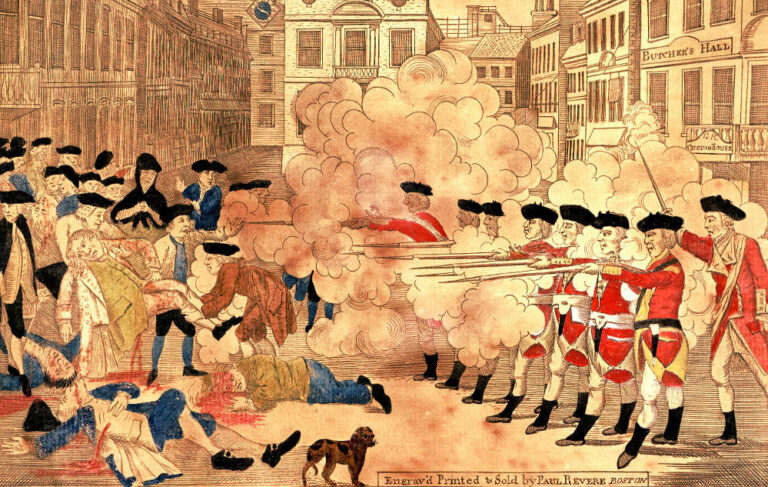Uneasiness over the presence of British troops had grown, not only because of the fear of armed soldiers but also because they were taking jobs and competing with local citizens. Boston was on the point of bursting into flames, altercations between locals and soldiers occurred daily.
Description of the Boston Massacre
On the cold winter night of Monday March 5th, 1770 a crowd gathered in front of the Customs House where a group of young citizens was confronting eight British soldiers commanded by Captain Thomas Preston. This incident started when a young man named Edward Garrick insulted Hugh White, the soldier on duty at the Customs House post. The soldier hit Garrick in the ear with the butt of his bayonet. He left angry and soon came back with a group of rowdy young men who confronted White with much foul language and threats. This situation led to the ringing of the meeting house bell, as in a call for fire, which drew the attention of more people into the King Street in front of the Customs House. Most people who congregated had buckets and according to witnesses the crowd was perhaps four hundred. Captain Preston, who at the time was posted opposite to the State House, a small distance from the Customs House on King Street, headed to the aid of Hugh White.
Captain Preston and his soldiers had to break through the crowd in order to get to the station and in doing so pushed several people with their rifles giving the impression that they intended to attack them. Most people in the crowd were peaceful but a group of 30 or 40 individuals led by a huge mulatto, Crispus Attucks, was striking at the soldiers with clubs and cutlass and throwing snow balls and chucks of ice. As they came close to the soldiers’ bayonets the mob dared the soldiers to fire shouting: “Come on you rascals, you bloody scoundrels, you lobsterbacks, fire if you dare, we know you dare not”. Sensible bystanders, like bookshop owner Henry Knox, urged Preston not give the order to fire. Preston had no control over the crowd, they knew that soldiers could not fire until they were read the Riot Act. This act ordered the dispersal of any group of more than twelve people who were “unlawfully, riotously and tumultuously assembled together”. If the group failed to disperse within one hour, anyone remaining was guilty of felony punishable by death without the benefit of the clergy.
The scene was tense and at this point one of the soldiers was hit with a club and a shot was fired. Six seconds elapsed followed by a round of shots. Eleven men were lying on the ground, four of them were dead, one died later of his wounds and six were wounded but survived. The crowd dispersed as soon as the shots were fired.
 Print of the Boston Massacre by Paul Revere
Print of the Boston Massacre by Paul Revere
Preston was enraged that his soldiers had fired without orders, he assembled his men and marched away unmolested by the stunned crowd. The dead were carried off and the wounded tended. During this time additional violence seemed certain as more citizens arrived and a fresh troop of British soldiers was trying to keep order. At which point Massachusetts Governor Thomas Hutchinson came to the scene. From the balcony of the second story of the Town House he told the crowd that Preston and his men would be tried.
As a member of the Massachusetts House of Representative John Hancock met with Governor Hutchinson to demand that the troops be removed from the city to Castle Williams. As a result there was no further violence in part because British troops were removed from the city and because Samuel Adams and the Sons of Liberty urged peace. They realized that they had a remarkable propaganda within their hands and it was time to use it to gain the minds of its citizens.
Captain Preston, the soldiers and four men in the Customs House were arrested and held in prison until their trial. The trial was postponed until the fall, giving time to draw the jury and to calm social tensions.
Dual nature of history
Paul Revere’s famous depiction of the Boston Massacre (above) shows the rebels’ point of view. But there are two sides of every story as different people portray historical events according to their own perspective.
British soldiers were in the colony to enforce civil order and protect officials from local rebels. They were being attacked by the mob and had to defend themselves.
The Boston Massacre was not really a massacre, only five people died. The historical event was used as propaganda by Samuel Adams and Paul Revere to convert liberals and moderates into separatists.
